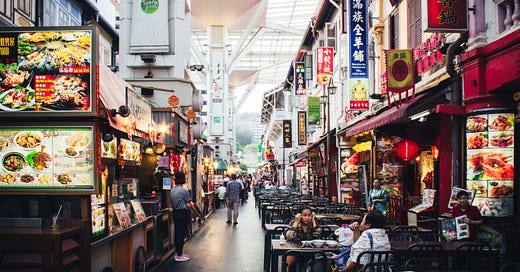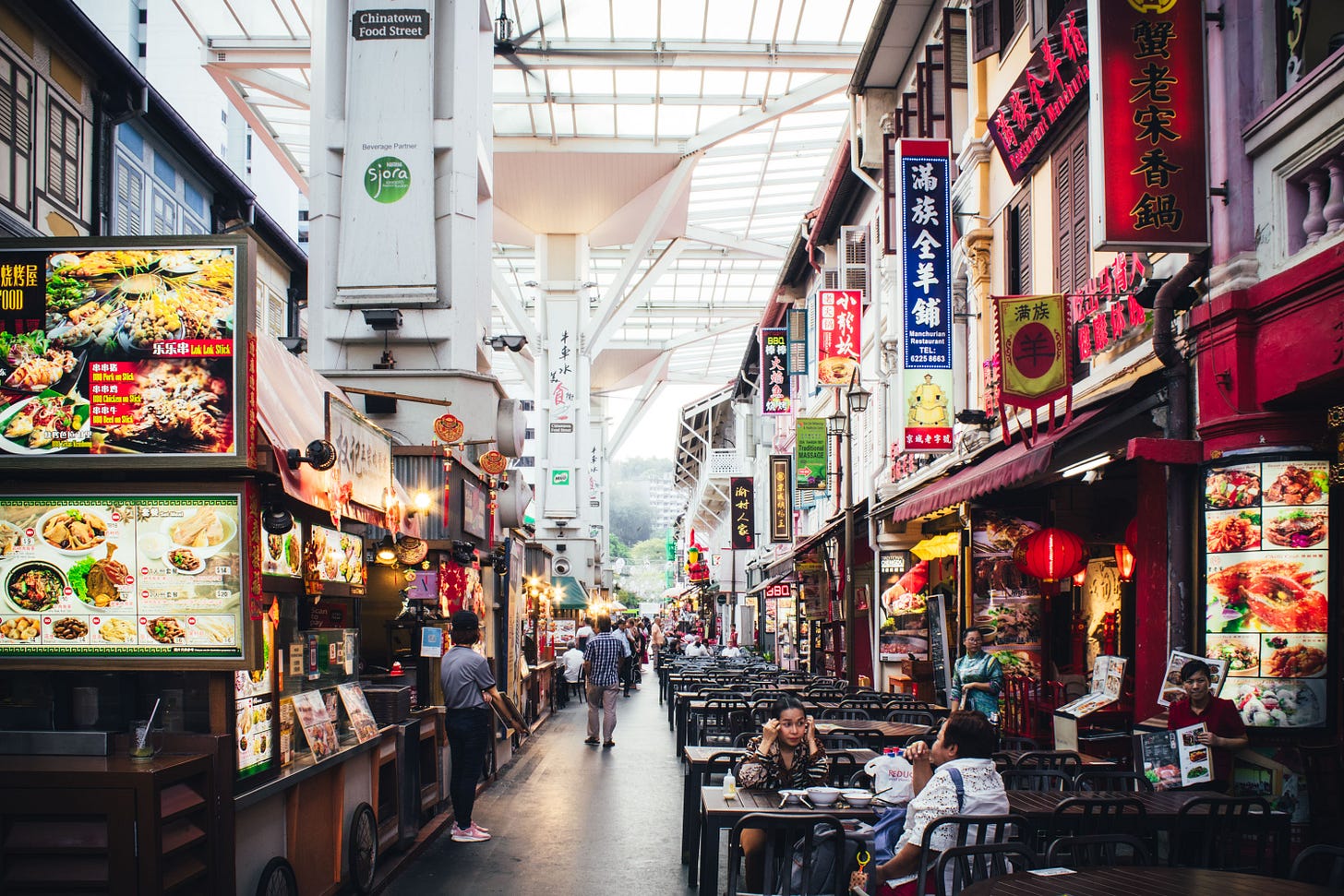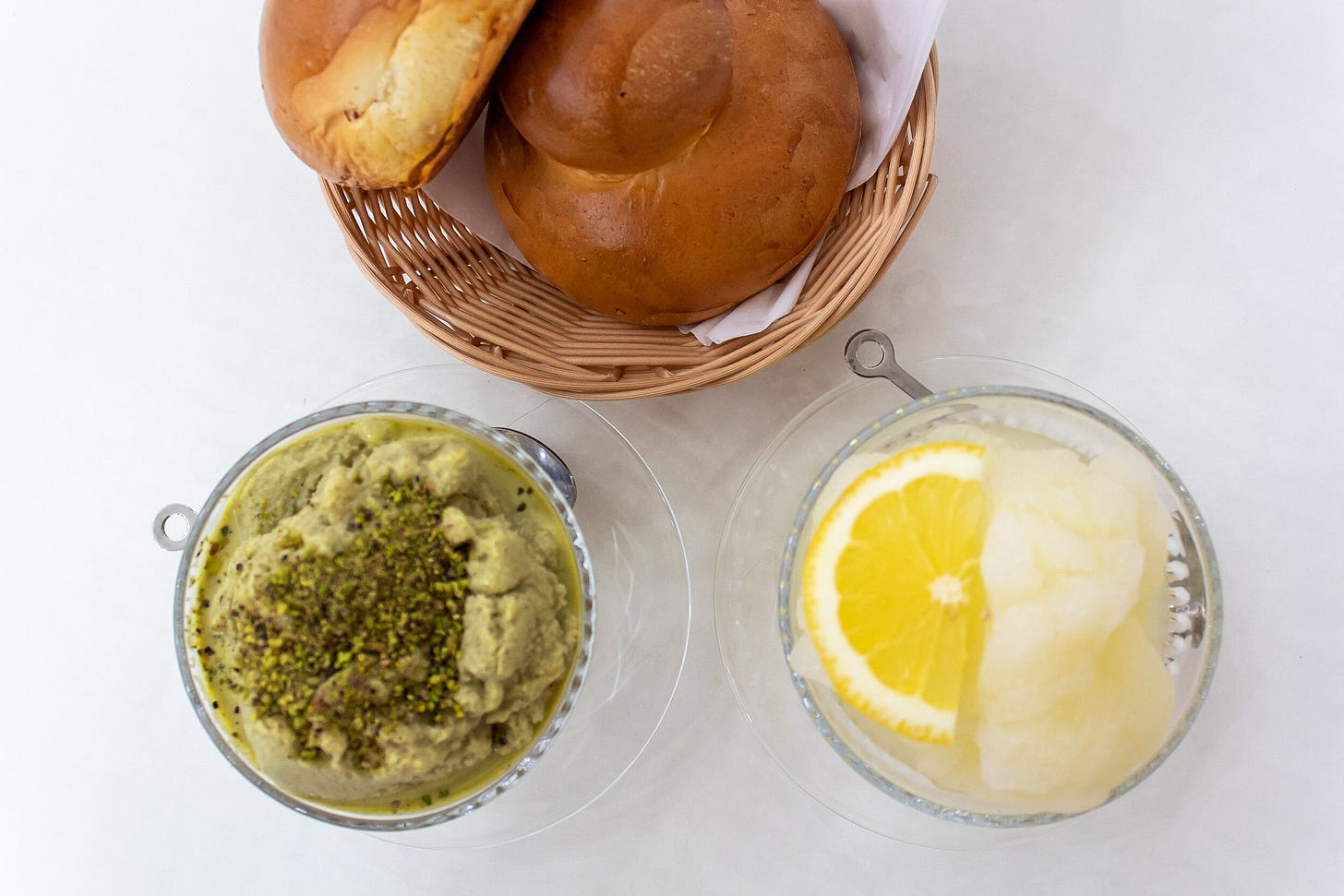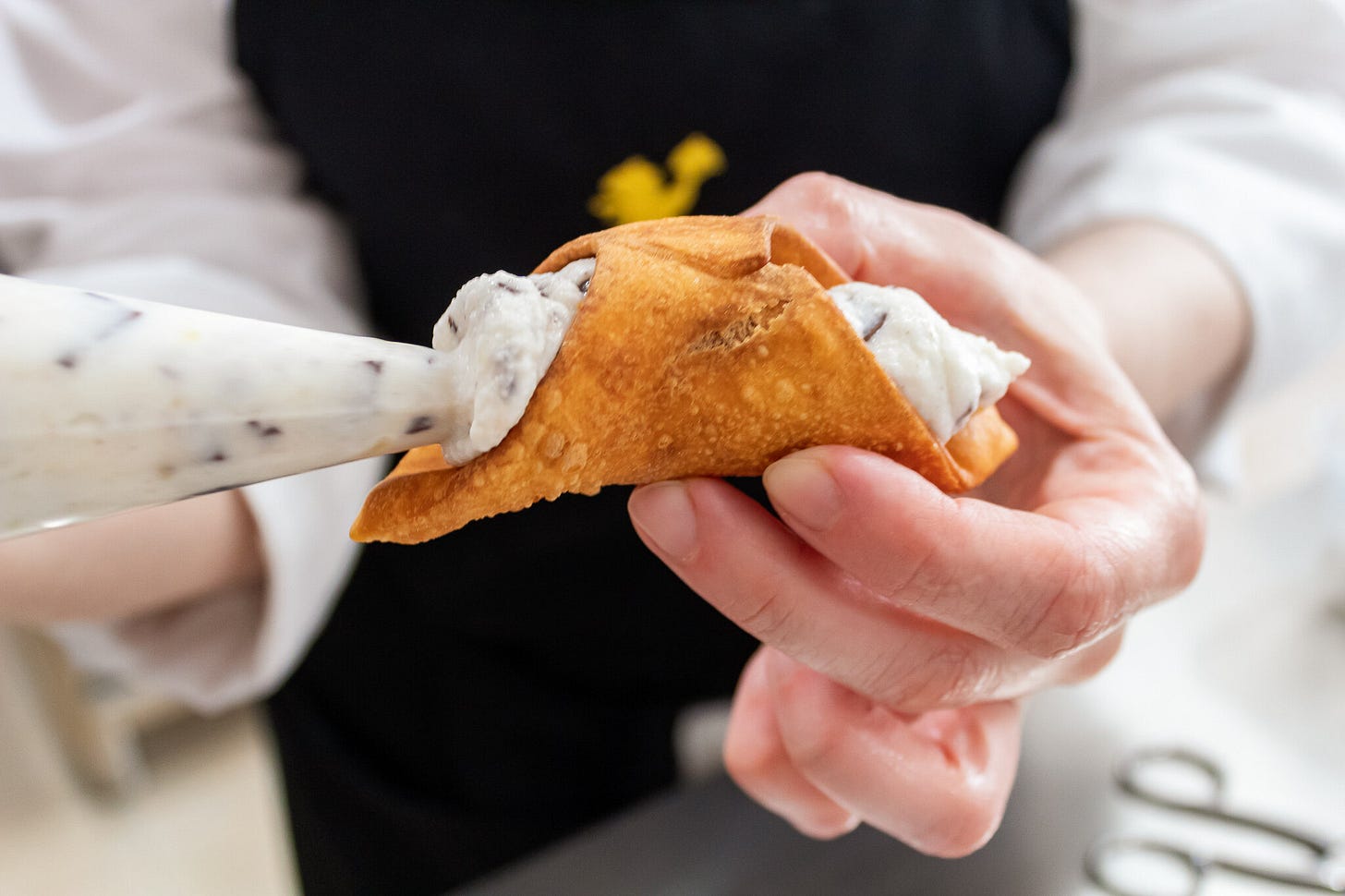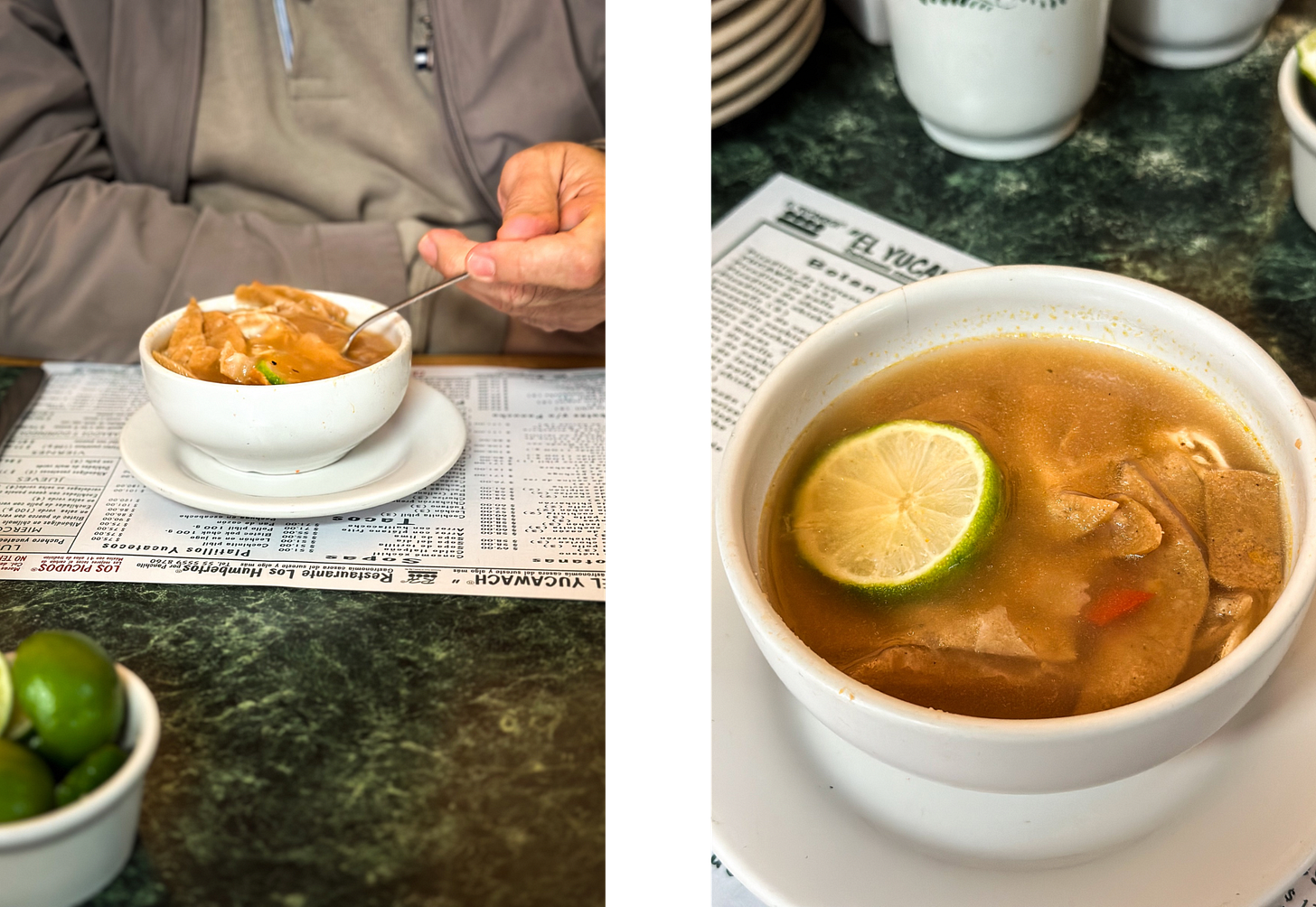When I started writing this list I thought it would be a short newsletter, but I quickly realized it wouldn’t be the case. I have been fortunate enough to live in many countries all around the world, and visit many others, so I have lots to share. I didn’t want to make the kind of list you can find in any food magazine or simply Googling “what to eat in Hong Kong”. I wanted to tell you my love stories with these places so maybe you feel inspired to visit them as well. Eating is such an emotional act and for me there are not many things as exciting as discovering a new dish to love.
Here I am sharing 5 food regions (there will be a part 2 and probably more), and the dishes I would come back to these places for.
Bangkok, Thailand
I have a confession to make. When people ask me “what’s your favorite food to eat in the world?” I want to say “Mediterranean food” because it’s no doubt one of my big loves, but the heart doesn’t lie and it beats for Thai food no doubt.
Thailand has a really special place in my life. I lived there for 4 years and it’s also where I met my husband and legally married (the celebration was in Northern Catalonia, to make up for the distance). But in Thailand, and more specifically in Bangkok, I also discovered another love that has come with me ever since. The love and curiosity for food. I wanted to understand every single ingredient I saw in the markets, I wanted to eat more of those vibrant flavors, I wanted to taste every fruit!
Thailand is a big country with many different food regions internally. It has received influences from India, China, and European merchants (that brought the chili pepper in the 16th century, for example), and you can taste them all throughout the kingdom.
In Bangkok, or Khrung Thep (City of Angels) for the locals, you can taste food from all over the country and beyond. Really good food. From street vendors, to family restaurants to fine dining ones, it’s one of the best cities in the world to eat.
What to order
There’s two ways to have a meal in Thailand. The first one is similar to the tapas concept, and it’s still an influence of the old palace courts. You order lots of different dishes to share and a bowl of rice each so everyone can mix things up to their will.
The other way is to eat a full dish by yourself. It could be a bowl of steaming noodles, eaten with chopsticks. Or it could be ahaan jaan diaw (อาหารจานเดียว), “food in a single dish”. I always found this very fun. In the markets and food courts there’ll be stands with lots of different prepared dishes. You just need to say which ones you want and they’ll add them to your rice plate for you, so it’s like being in a buffet! It can also be just rice with one of the prepared dishes if you don’t want to mix up.
What I would come back for
I have thousands of food memories about Bangkok, but here are the ones I cherish the most:
Or tor kor (ตลาดอตก) is one of the best places I have ever been to. It’s a market close to the famous Chatuchak in Bangkok (known to be the biggest thrift market in the world). But this one is rarely visited by tourists. Ross and I would go there every Saturday morning to do the grocery shopping for the week and to have breakfast in the designated food area. You can try many less-known local delicacies there, like nam prik (น้ำพริก) -dipping sauces- but also have amazing duck noodles, fresh fruit slushes and oyster omelettes!
Pad kapraw (ผัดกะเพรา). This is my favorite Thai dish of all times. And believe me, I gave this a lot of thought because I really like eating many of them! But I always come back to this simple stir-fry when I feel nostalgic (which is often), even now living in Boston. It’s ground pork/chicken stir-fried (pad) with holy basil (kapraw), chilies and a savory sauce. Served over rice, of course. In Bangkok, I would have this for breakfast if I went to a market or for lunch or dinner in a family restaurant. It was (and still is) a fantastic take-away as well. Thai people, specially in the big cities, don’t tend to cook much at home anymore, so they normally buy their meals in the street or markets and reheat them at home. I don’t blame them, the experts know better!
Cha nom yen (ชาเนมย็น). This is known as Thai tea but it literally means “cold tea with milk”. I cannot drink it anymore without first taking a bunch of lactase pills, but at home I substitute the cow milk for oat. Still, the street version has no parallel. The tea is special by itself. It has a tinted orange color given by added spices and Cha Tea Mue, the company that popularized it, keeps the blend a secret. It is drank sweetened by condensed milk and evaporated milk and it is delicious!
Laarb moo (ลาบหมู). In Thai cookbooks this dish is in the “salad" section and it always makes me chuckle. Ground pork lightly boiled and served with fresh herbs, chilies, shallots and sticky rice. It is surprisingly fresh, and delicious. I would eat it very very often, specially in Pier 21, the food court of a popular mall in Bangkok. There is was good and very cheap. I mean 50 cents cheap. I know!
Issaya Siamese Club. I would come back to Bangkok for all the street food and market dishes but also for this. I sometimes still dream of this colonial villa restaurant. The dishes are refined and they transport you to another era. I have had precious meals there. Beautiful dates with Ross and fun times with friends and family. Sitting by the tropical garden with an iced cocktail in hand and a massaman curry in front of you is a scene made in heaven.
Singapore, Republic of Singapore
Singapore is a melting pot of cultures and this is a situation that is always favorable for food. It also happens in other cosmopolitan cities like Dubai or New York. But in Singapore the melting pot is very regionalized, so you can find amazing Chinese food from different gastronomic regions, delicious Indian and Pakistani dishes and fantastic Malay cuisine. And then there’s the fine dining and hip spots.
My favorite places to eat the local food is always the markets. And in Singapore there’s many. They are called hawkers and they are busy with locals and visitors alike that want to get their bellies full.
What I would come back for
Maxwell Road Hawker Centre and Chinatown Food Street. I have great memories from these food halls. Located in Chinatown, they bring an amazing opportunity to try many Chinese dishes for very little. In my mind is the Hainanese chicken, so flavorful yet so clean, and the Bak hut teh, “meat bone tea”, a herbal pork rib stew brought to Singapore by Fujian’s Hokkien immigrants.
Tekka Centre. This food hall is next to the Little India metro station and it’s a fantastic way to finish up your day! I remember having fantastic mutton biriyani as well as great masala dosas!
Chilli crab. This is the national Singaporean dish and you can find it everywhere! It is messy (mud crab cooked in a thick gravy) but really really tasty. I love it with the little sweet buns they bring so you can dip all the sauce away.
Char kway teow. This is a classic street food dish in Singapore and Malaysia but it has Southern Chinese origins as many others do. It’s stir-fried flat rice noodles cooked in dark soy sauce making a delicious savory dish. The kind of pick-me-up you need after hours of walking around beautiful gardens!
Sugarcane juice. I still clearly remember the first time I saw this green drink in a food hall. I approached the stand and saw how they pressed the sugar cane to extract all the juice. You won’t get nearer to tasting the sugar source than with this. Sugarcane is actually native to South East Asia. It was exported first to the Middle East and Europe by the Arabs during the Middle Ages and centuries later to the American continent where the production was heavily related with slavery. Drinking the sweet and earthy beverage you couldn’t imagine anything wrong could come out of it, though.
Sicily, Italy
I spent six months in Northern Italy with a local family some time ago and they made me feel a bit nervous about the South of the country. They wouldn’t do it maliciously but they would make comments sometimes or certain jokes about the terroni that made me feel like it may not be a good idea to visit the area.
Any ingrained racism is made out of a mountain of prejudices. And I crashed them all when I visited Sicily. It is now my favorite region in all Italy. The term terroni (people that work the land) that had so many bad connotations in the North, gained all the positive ones from my eyes. Sicilians are people proud of their land, of what it offers and actually such land serves the needs of the rest of Italy. The grain produced there feeds the pasta needs of the Republic.
What I would come back for
The Etna region. I fell in love with cities like Randazzo and Bronte (which pistachios are world-famous), and with the fertility of the volcanic land. Apart from the nuts, fruits and vegetables, they also have amazing salami from a pork variety that pastures free around the Nebrodi mountains since the times of the Greeks. I remember many meals cooked in our guest house with produce from the local markets and enjoyed in the garden. Just wonderful.
Granita di mandorla /limone /pistacchio. This may be the best sweet breakfast in the world. Imagine waking up, going for a walk in a lovely historical town, stopping by a café and being served flavored crushed ice with a huge brioche. I am talking ice-cream for breakfast! This is the ancient way to make ice-cream and it was introduced by the Arabs that populated the island for centuries. They also brought the main ingredients to make this: the almonds, the lemons, the pistachios and even the sugar. We owe them so much!
Mercato di Ortigia. This market is located in the beautiful area of Ortigia in Siracusa. The city is astonishing by itself but walking around the market makes you appreciate the variety of produce from the area. Oranges, almonds, pistachios, sword fish, ricotta, salumi, arancini, caciocavallo cheese… Ross and I lined up at a corner where they were making sandwiches and took them to a lovely secluded beach to have lunch in front of the sea. What else can you hope for?
Pasta alla Norma. The name of this dish references the opera Norma by Vicenzo Bellini. It is said that in 1920 a famous person from Catania went for lunch to a friend’s and when he tried this dish exclaimed “this is a real Norma!”. It is not much (pasta with tomato sauce, fried aubergine and salted ricotta) but I agree that it equals an artistic expression. I love how aubergine (another introduction from the Arabs) is featured in Sicilian cuisine. You can find it in a caponata, in the melanzana a beccafico and even inside arancini.
Cannoli di ricotta. Even if nowadays you can find cannoli in many places outside of Sicily and Italy, I would come back to the island for them. In Catania I learnt to make them from scratch which was very insightful. When I travel to a new place I always take at least a cooking class. This one was on the second day after arriving and it was based on street food. We actually were the first students ever to this academy and the cooks were so nice! They taught us how to make arancini and cannoli and my appreciation even increased after visiting a dairy farm about two weeks later. There we saw how ricotta was actually made and after tasting it fresh in other cannoli, I thought that it was the perfect way to close the circle.
Yucatán, Mexico
The first time I travelled to Yucatán was also the first time I took a solo trip. It is a bit misleading because I went to the south of Mexico invited by Mariana, a good friend from university. Her parents lived there and I accompanied her to see them on our summer break. After two fantastic weeks with them I took a very long bus to Chiapas, a mountainous and jungly region known because of the rebel zapatistas, but also because of the beautiful natural landscapes and Mayan ruins. I came back to Cancun 7 days later feeling full of energy and adventure. I guess my spirit was contagious because they wanted to show me more of Quintana Roo and Yucatán and we took several trips around with Mariana’s family. I only have great memories from that area.
What I would come back for
Cochinita pibil. This dish blew my mind and still does every time I try it again. I think it’s the most delicious pork dish I have ever had. Traditionally it is cooked in a hole underground heated up with smoking stones and buried for hours. This pit is called pib in Mayan, and the marinade also incorporates a local spice called achiote that gives it the red tint to the meat and makes it extra delicious. The lime and orange juice in the marinade just balance it up, freshening the flavor. You end up having a perfectly tender pulled pork with incredible taste just ready to fill your tortillas.
Sopa de lima. Before tying this, I thought I was not really into soups. But this is not a European hearty soup. This is fresh, spicy, citrusy and super! The lime is actually Mexican lime (Citrus × aurantiifolia) also known as key lime, which is a different variety to the Persian lime, or just “lime” (Citrus x latifolia). Curiously, Mexicans call the latter limón, which makes things a bit confusing but also more fun.
Panuchos. In Mexico they have many ways to eat their corn tortillas, and many shapes. This one is a favorite of the region and consists of tortillas filled with beans and then deep fried. Normally afterwards you get shredded chicken with pickled shallot and habanero sauce on top, or something else. They are very tasty, messier than other tortilla dishes but you only need about three to fill you up!
Aguas de sabor. In Mariana’s house, Flor, her mum, would prepare every day a different agua de sabor, “flavored water”, and I loved it. She would get some fresh fruits every morning and squish the juice in a pitcher and then fill it up with water and ice. Sometimes there was also mint or different fruits altogether. I never had problems drinking water, but this was an even bigger incentive. Still, my favorite of all is agua de horchata. It is very funny because my father actually has an horchata factory back in Barcelona, but the horchata drank in the Spanish Mediterranean coast has little to do with the Mexican one. Both are vegan (or should be). My father makes a summer beverage out of a tuber called tiger-nut (African in origin). In Mexico they took the name but their drink is made out of rice milk, sugar and cinnamon. Pure bliss, both of them.
Flor’s breakfasts. Flor and Edu, Mariana’s parents, don’t live in Cancún anymore, but if I could, I would go back for Flor’s breakfasts. Fijoles with avocado, sour cream, cottage cheese, tortillas, egg… They were simple to their eyes but a wonder to mine. I had never had such a feast for breakfast before and it changed the way I thought of this meal.
Istria, Croatia
Ross knew of this Croatian region by his Serbian colleagues. Serbs love to drive to their holiday destinations, even if they take as long as 8 hours (for Western Europeans seems like a crazy long time!). They like going to Greece, to Montenegro and to Istria, where they share a common language.
While living in Budapest, Ross and I decided to give it a try and we drove there. Americans reading this will be astonished at the fact that in 6 hours we crossed almost two countries. Half Hungary and all Slovenia to get to the Istrian region of Croatia. It didn’t take long for me to fall for this place.
The tourism here is more regional and local as international tourists tend to go to Italy, which is very close by, or to Southern Croatia. This means the region still keeps its charm. Its gastronomy is centered by the produce they grow or catch: seafood and fish, truffles, pork, wine… And also by common techniques shared with bordering countries. For example, they also love their fresh pasta.
What I would come back for
Fuži s tartufima. I honestly would take a plane right now for this. Istria is one of the few places in the world where you can find truffles, the climate and the soil are perfect for them to grow. Ross and I went to hunt for black truffles with specialists and their humans. The specialists are the dogs here, they are the ones that can smell and dig up the delicious treasures. We then cooked a simple yet beautiful truffle omelette for lunch. Truffle is very present in many dishes but I think the match made in heaven is with their fresh pastas. Their two favorite local varieties are fuži (small squares of pasta diagonally rolled into tubes) and pljukanci (longer pieces spindle-shaped). I have a special restaurant I am going to disclose to you now, use the information with caution: Restaurant Zigante in the tiny town of Livade will serve you perfect pasta with truffle sauce, so perfect you will want to come back for more the very next day. Which is what we did.
The fresh fish from Novigrad. Coastal towns in this part of the world are just gorgeous and you will probably eat very well almost anywhere. But I had an amazing meal I cannot shake off my mind and it was in a little tavern in the city of Novigrad, Konoba Cok. We got the last table one evening and minutes later a waiter was greeting us with a big platter of different fresh fishes. Caught that same morning. We just picked one and it was served to us with greens, boiled potatoes and olive oil. It didn’t need anything else.
Oleum Viride Belic. After doing a cooking class that was fantastic, cooking fresh seafood pasta, fish and figs, the cook advised on some specific products that were top quality and very admired by local chefs. One of this was the olive oil we had been using and so we went to do a tasting the next day to their shop. It was incredible. They had more than 10 different bottles with different varietals and blends. Like fine wine. Actually quite like it because they won some global awards many years consecutively. Their production is very small and that’s why they can pay all the attention to have an outstanding product. We bought several bottles as we were traveling by car but I wish I could get some more now!
I hope this list entices your curiosity and your appetite. There will be a part 2 and perhaps a part 3 if you find it useful. For more specific things, leave a comment down below!


